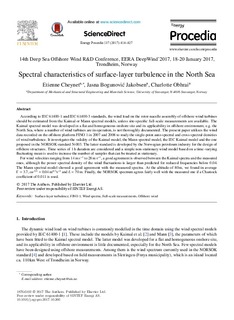| dc.contributor.author | Cheynet, Etienne | |
| dc.contributor.author | Jakobsen, Jasna Bogunovic | |
| dc.contributor.author | Obhrai, Charlotte | |
| dc.date.accessioned | 2018-05-22T08:32:28Z | |
| dc.date.available | 2018-05-22T08:32:28Z | |
| dc.date.created | 2017-12-17T16:55:53Z | |
| dc.date.issued | 2017-10 | |
| dc.identifier.citation | Energy Procedia. 2017, 137 414-427. | nb_NO |
| dc.identifier.issn | 1876-6102 | |
| dc.identifier.uri | http://hdl.handle.net/11250/2498649 | |
| dc.description.abstract | According to IEC 61400-1 and IEC 61400-3 standards, the wind load on the rotor-nacelle assembly of offshore wind turbines should be estimated from the Kaimal or Mann spectral models, unless site-specific full-scale measurements are available. The Kaimal spectral model was developed in a flat and homogeneous onshore site and its applicability in offshore environment, e.g. the North Sea, where a number of wind turbines are in operation, is not thoroughly documented. The present paper utilizes the wind data recorded on the offshore platform FINO 1 in 2007 and 2008 to study the single-point auto-spectral and cross-spectral densities of wind turbulence. It investigates the validity of the Kaimal model, the Mann spectral model, the IEC Kaimal model and the one proposed in the NORSOK standard N-003. The latter standard is developed by the Norwegian petroleum industry for the design of offshore structures. Time series of 1 h duration are considered and a simple non-stationary wind model based on a time-varying fluctuating mean is used to increase the number of samples that can be treated as stationary.
For wind velocities ranging from 14 m s-1 to 28 m s-1, a good agreement is observed between the Kaimal spectra and the measured ones, although the power spectral density of the wind fluctuations is larger than predicted for reduced frequencies below 0.04. The Mann spectral model showed a good agreement with the measured spectra. At the altitude of 80 m, we found in average Γ = 3.7, αϵ2/3 = 0.04 m4/3s2 and L = 70 m. Finally, the NORSOK spectrum agrees fairly well with the measured one if a Charnock coefficient of 0.011 is used. | nb_NO |
| dc.language.iso | eng | nb_NO |
| dc.publisher | Elsevier | nb_NO |
| dc.rights | Attribution-NonCommercial-NoDerivatives 4.0 Internasjonal | * |
| dc.rights.uri | http://creativecommons.org/licenses/by-nc-nd/4.0/deed.no | * |
| dc.title | Spectral characteristics of surface-layer turbulence in the North Sea | nb_NO |
| dc.title.alternative | Spectral characteristics of surface-layer turbulence in the North Sea | nb_NO |
| dc.type | Journal article | nb_NO |
| dc.description.version | publishedVersion | nb_NO |
| dc.rights.holder | © 2017 The Authors | nb_NO |
| dc.source.pagenumber | 414-427 | nb_NO |
| dc.source.volume | 137 | nb_NO |
| dc.source.journal | Energy Procedia | nb_NO |
| dc.identifier.doi | 10.1016/j.egypro.2017.10.366 | |
| dc.identifier.cristin | 1528538 | |
| cristin.unitcode | 217,8,5,0 | |
| cristin.unitname | Institutt for maskin, bygg og materialteknologi | |
| cristin.ispublished | true | |
| cristin.fulltext | original | |
| cristin.qualitycode | 0 | |

